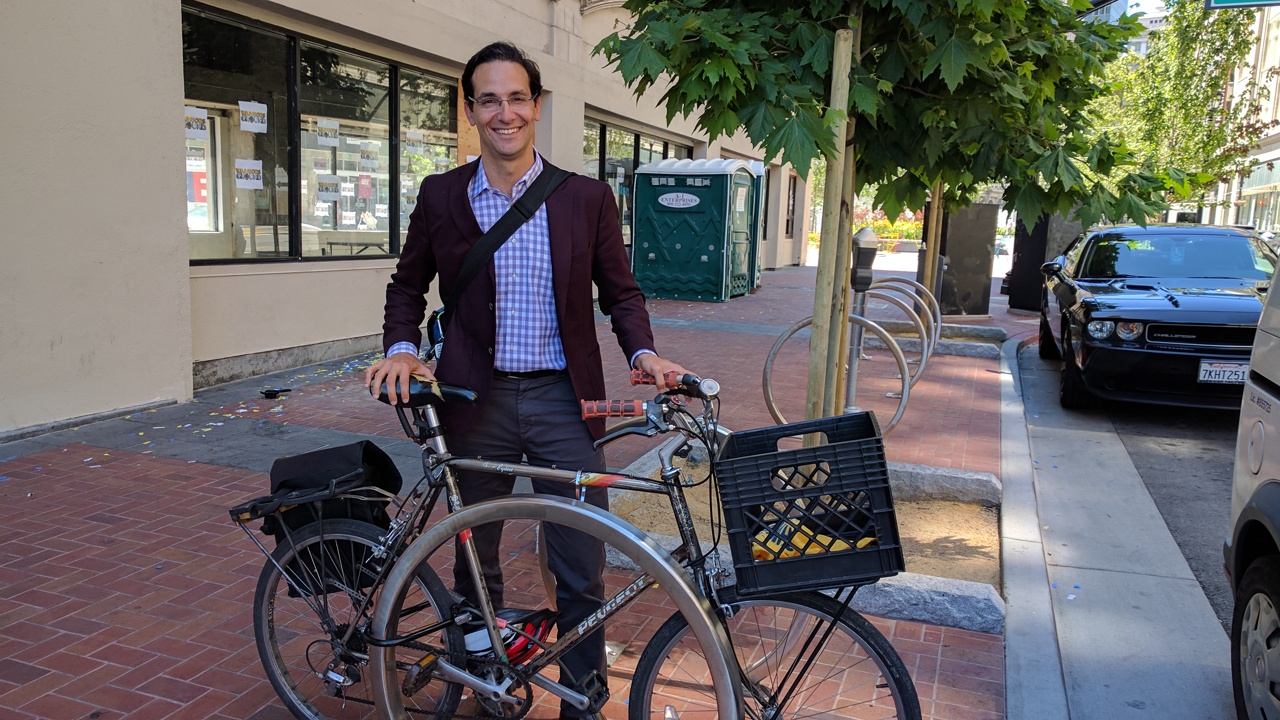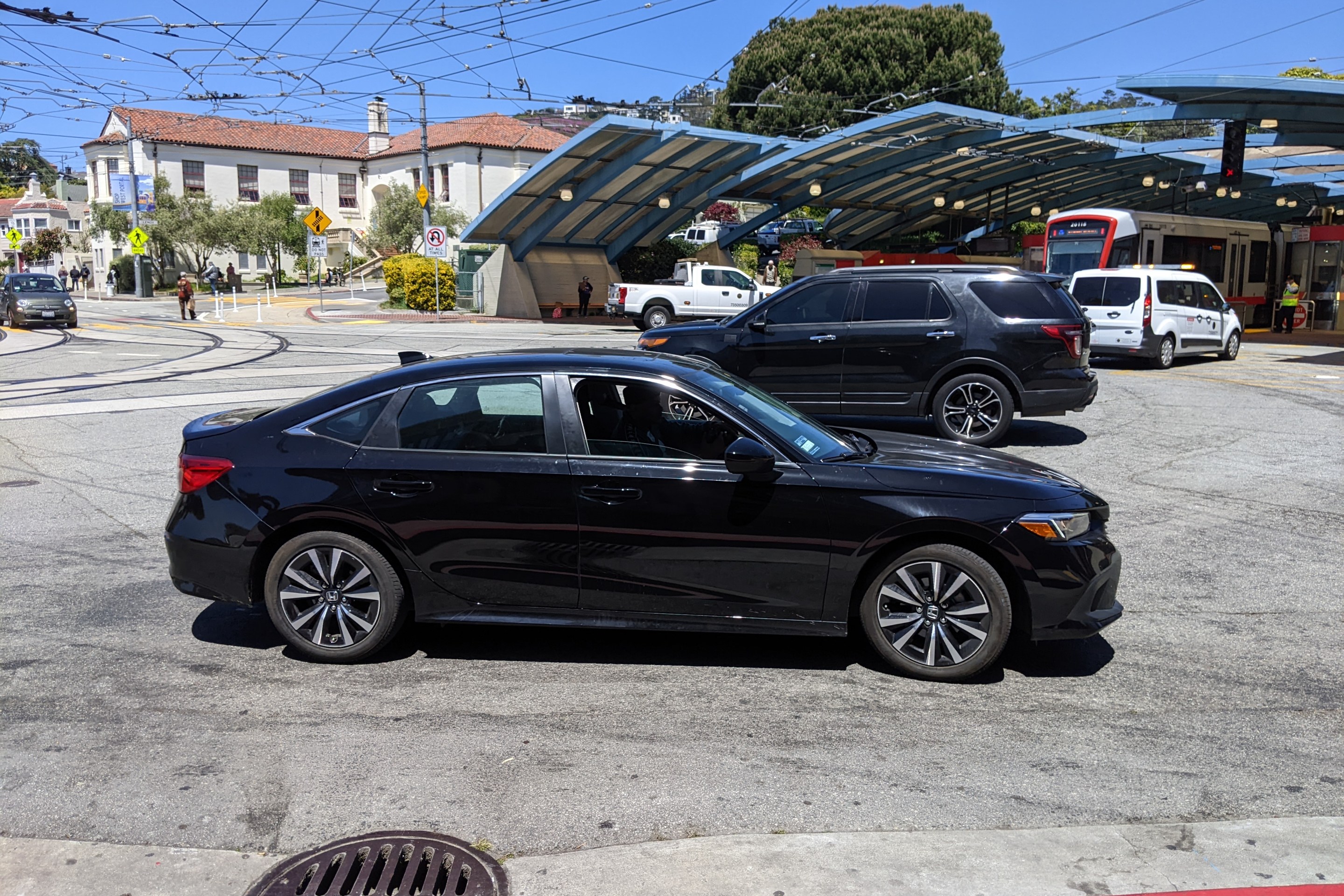A Talk with the Head of Oakland’s DOT
4:18 PM PDT on June 19, 2017

Russo with his trusty steed. Photo: Streetsblog/Rudick
The reins of Oakland's newly formed Department of Transportation were turned over on May 8 to Ryan Russo. Russo, formerly New York City DOT's Deputy Commissioner of Transportation, oversaw many of the bike and pedestrian-friendly street redesigns that New York is famous for. Russo is off to a busy start. He got here just in time for Bike to Work Day, the opening of Oakland's first curb-protected bike lane, the opening of the Yerba Buena Vista Point, and, most recently, the Warrior's parade.
Streetsblog caught up with Russo on Friday near his office in downtown Oakland to talk about how he's settling in, what he thinks of the strides Oakland has made so far, and how he will shepherd the department towards a safer, more equitable and more sustainable future.
Russo had just come from a discussion about the future of downtown parking with the Oakland Chamber of Commerce.
**
Streetsblog: Did you convince them we don’t need so much parking?
Ryan Russo: We made progress in helping them understand the potential of a more efficient parking system and that we have a lot of existing parking assets ... if any future parking is priced, managed, shared and commoditized, like an Airbnb for parking, we have a strong marketplace for it, where commuter parking can be used for evenings. We can minimize the amount of new parking as downtown gets denser. They seem excited about the potential for that.
SB: So they got that more parking isn't the solution?
RR: People in the room got it ... It’s the people who finance the buildings who don’t yet get it. Or the tenants who are concerned that their employees, tenants, visitors and clients will come downtown to a meeting and say they couldn’t find parking ... if the clients aren’t happy coming to the offices they won't stay as tenants. It’s a real fear that business feel right now.
SB: So there's a learning curve with getting parking used more efficiently. Speaking of which, I guess it's a good thing that people came to Thursday's Warrior's Parade by transit.
RR: We were expecting about 1.5 to 2 million people. BART did such an amazing job. The police and the city and the team that managed the event did great. It was great to see our streets used for that civic purpose, all the people lining Broadway ... Measure DD funded the lake improvements that reconstructed the road in front of the lake and that became the civic space ... seeing all the people there is emblematic that if you make those investment in non-freeway-like public infrastructure you see what you can get out of it. It was great to see.
SB: Speaking of which, Oakland has a problem with freeway infrastructure cutting it into segments--think of Jack London, West Oakland, etc. What can Oakland do to reconnect its neighborhoods?
RR: Short term, we’re looking to form partnerships in enhancing the public realm with treatments you can do to the underpasses, such as better lighting and better street and bike design that can better stitch them together. I think Oakland can now be a better partner in planning and that we should think bold and visionary around Oakland’s role in the region ... there’s a big discussion about 980, that planning needs to get kicked into gear.
SB: Could I-980 get turned into a boulevard?
RR: That’s a long-term project. But you move it forward by figuring out what you want to do. We have to study how you would manage all the issues ... the West Oakland community in particular has to think about a vision that serves them and rights that historic cut in their community.
SB: What do you think is Oakland's most impressive recent accomplishment?
RR: Passing KK with 82 percent of the voters, and statewide the passage of S.B.1, were a major recognition of the need to support our public rights of ways. That’s what’s going to make this job fun--putting that to work. Oakland's not used to having these kinds of resources so now we have to figure out how to deliver in the street.
SB: So KK's about repairing the streets. How do you deliver? What's the strategy?
RR: As we go forward and plan for KK, and we do our bike plan, and we do everything ... were going to incorporate equity into that process ... the pedestrian plan that’s about to be adopted used a number of metrics to map communities of concern and use it in the project prioritization for our high injury network that will be part of our Vision Zero efforts. The capital improvement plan in front of the city council, the five year paving program and paving projects, have been mapped to reflect the level of investment in high need versus low need communities. We’ll both use this data to sort of weigh our investments and track how much we’re doing. And we’ve also got funding to do community-based planning in East Oakland, where we can have a robust dialog with communities that are used to having government just make decisions for them. We’ve scoped the bike plan to support local community based organizations.
SB: Can you give an example of a community and a project and how this would apply?
RR: Take the 98th Avenue road diet in East Oakland. A prior generation said 'this is a street that connects the hills to the airport and that’s its sole function.' Meanwhile, there are schools and houses ... but the traffic signals, the parking, it's all oriented to getting people to and from the airport. Nobody ever asked 'is it hard for your kids to get to school?'
SB: And now you're asking.
RR: It’s on the paving list and we are pursing a road diet. We're talking with the community about where those crossing are most challenging. But for some people there’s a level of distrust.
SB: How so?
RR: They don’t necessary trust that we have their best interests in mind.
SB: Because the government hasn't in the past.
RR: (Nodding) It’s very hard for a team that’s been under-resourced to have those high quality public conversations and engagements. That’s a capacity that we need to build.
SB: So you're hiring more outreach people?
RR: Just hiring more people.
SB: How's it going with the city council?
RR: I'm in my 'get to know you' phase with the councilmembers. And I’m very impressed with how dedicated to the communities they are and open to this conversation they are, because I think they need to be partners as we launch this. They're impressive--on progressive policy changes, parking reforms, etc.
SB: This publication has been critical of bike infrastructure in both Oakland and San Francisco and the way intersections are treated--or not treated, as is usually the case. Telegraph has its parking-protected bike lane treatment, but it stops at each intersection. Is that going to change on your watch?
RR: In Oakland we don’t mark anything through the intersection and we are looking at that. I totally agree the intersection is kind of where the action is ... the block is where you need to provide the feeling of safety, and it’s where people feel unsafe, but the risk tends to be at the intersection. People have been throwing a lot at the wall to see what sticks in this country and there’s been innovation and we have green conflict zones, as a strategy, but I’m very interested in improving things and extending that feeling of comfort and true safety through the intersection.
SB: When will Oakland get its first protected intersection?
RR: We have a protected intersection schematic designed from a grant we won. It will come to the intersection of Grand and Harrison. We just won the grant so it’s typically two to three years from design to construction.
SB: Great. Will we see any short-term, 'pop up' infrastructure? Planters, bollards, that kind of thing?
RR: Under KK and under the DOT ... there are things that can be deployed quicker. Where and when we have capacity to do striping, signage, signal construction, we'll do projects that seem to kind of 'pop up' if you will. But there are challenges because of capital funding and inter-bureaucratic hurdles, but I think it’s vitally important for a DOT to have that capacity to act quickly.
SB: When Streetsblog did its tour of Oakland infrastructure a few months ago, it was disappointing to see brand new stuff--such as a guard rail on Lake Merritt Boulevard, on the right side of a new bike lane, instead of the left, where it could actually protect cyclists from getting run over. What are you doing to make sure all the Oakland departments are on the same page?
RR: For new projects and upcoming projects, we want to make sure that we are on the cutting edge and they're designed using the best tools possible. We are updating internal design guidelines to make sure that everything in the pipeline does those things. That’s something we’re looking to complete later this year. You haven't asked me about bike-share.
SB: Okay, talk about bike-share. Obviously, New York's has been around for a few years, so bike-share's hardly theoretical for you.
RR: I’m very excited for the East Bay to see what bike share can do. It can be a game changer for cycling, the perception of cycling in a region, and its ability to solve some of the last-mile transit problem. I’m really proud of the equity component in the bike-share program, where low income Oaklanders will be able to join for the first year for five dollars and they can pay cash if they don’t have credit card card. I think it speaks to how we’ve operationalized equity into transportation initiatives; focusing on getting people to jobs and opportunities while saving them money and time.
SB: Any last thoughts on Oakland?
RR: I’m really encouraged by the commitment, not just the Oakland DOT team, but the whole city government's commitment and passion for the city. I’m excited to join that. But there are also fundamental nuts and bolts challenges we need to solve ... we’ve given ourselves a wonderful to do list.
This interview was edited.
Stay in touch
Sign up for our free newsletter
More from Streetsblog San Francisco
Commentary: Merchants Are Getting People Killed
The number one local obstruction to curbing traffic violence is local commerce and merchant groups.
Supervisor Melgar Betrays Promises, Sells Out Family Killed in West Portal
Well that didn't take long




